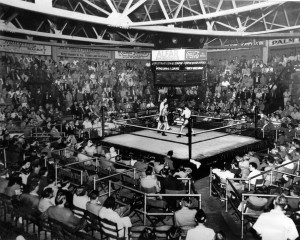Fisticuffs in Downtown WPB
 It was a fine day in sport on September 2, 1929. The Chicago Cubs were closing in on a pennant, Bobby Jones set out to defend his title at Pebble Beach, and the American Legion Arena was opening on Clematis Street.
It was a fine day in sport on September 2, 1929. The Chicago Cubs were closing in on a pennant, Bobby Jones set out to defend his title at Pebble Beach, and the American Legion Arena was opening on Clematis Street.
That’s right. A brand new boxing arena in the 400 block of Clematis, right near the train tracks, featuring 2,380 seats, modern lighting, and “a ventilation system” that would allow the afternoon breeze to cool those in attendance. Opening night would feature Kayo Billy Dugan of Georgia against Jeff Carroll of Mississippi in a heavyweight bout between two “ponderous pachyderms.” Many matches would follow, some of which would showcase fighters sponsored by none other than E.F. Hutton. The arena would, on occasion, even feature pugilists as young as 11 years old.
One particular fighter, who enjoyed quite a run in the arena and surrounding area, was Philip Dillon O’Connell, Sr., who impressively opened his career with 59 straight victories before having his jaw broken in Round 1 of his 60th fight. Though in a losing effort, he would go the distance in that bout. Just days later, having had his jaw wired shut at Good Samaritan Hospital, he drove to the University of Florida and enrolled in law school, thus ending his boxing career. Before long he was elected a municipal judge, and he would ultimately serve as Palm Beach County state attorney from 1935 to 1961. He died in 1987, survived by, among others, Stephen C. O’Connell, for whom the Florida Gator basketball arena in Gainesville is now named.
Though boxing was the main attraction at Legion Arena, other events would take place there. Charity functions and fundraisers were held there, and on at least one occasion customers were treated to a mud wrestling extravaganza. (Not the type of mud wrestling that brought Joseph “Blue” Pulaski to his fateful end, mind you, but entertaining nevertheless.) In all, the arena would serve as host to boxing matches for well over a decade. But by the early 1940’s, the television market began to change the boxing landscape, and local arenas began falling by the wayside. Such was the fate of the American Legion Arena on Clematis Street, but not before it enjoyed one heck of a good run.
(Arena photo courtesy of Buddy and Roseanne Bush, by and through Historic Palm Beach and the Palm Beach Post)
